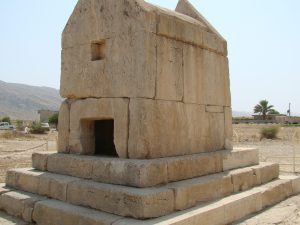Gūr-e Dokhtar/Bōzparگور دختر/بزپر
Location: Gūr-e Dokhtar is a solitary monument in the Plain of Bōzpar in Fars, southern Iran, the Province of Bushehr.
29°13’00.9″N 51°39’04.0″E
Map
Historical Period
Achaemenid
History and description
Gūr-e Dokhtar (the Maiden’s Tomb) stands in the Bōzpar valley surrounded by hills 100 km southwest of Kazerun (figs. 1 ). No historical mention of such a tomb exists in ancient and medieval sources. Gūr-e Dokhtar consists of a rectangular chamber, 5.20 x 4.50 m, sitting on three receding plinths and capped with a gabled roof made of large stone slabs. The height of the monument is 4.45 meters. The tomb chamber, 207 x 220 x 160 cm, can be accessed by means of an entrance (89 cm high and 67 cm wide) on the north side. As Stronach has noticed, this situation is reminiscent of the location of the tomb of Cyrus the Great in the Pasargadae plain, facing a majestic gorge called Tang-e Bolaqi (Stronach, Pasargadae, p. 301).
Archaeological Exploration
The monument was first reported by Richard N. Frye while working on the Sasanian inscription at Sar Mashad in 1948. In 1950, Walther B. Henning attempted in vain to visit the monument but was unable to reach the Bozpar valley because of road conditions in the region. In 1961, Louis Vanden Berghe visited Gur-e Dokhtar and published the first thorough description of the monument with illustrations. Vanden Berghe Compared Gur-e Dokhtar with the similar Tomb of Cyrus at Pasargadae and, after a long discussion on Achaemenid funerary monuments, concluded that Gur-e Dokhtar was the tomb of an early Achaemenid king, possibly Cyrus I, the grand father of Cyrus the Great (Vanden Berghe, “Le tombeau achéménide de Buzpar,” p. 257). Further investigations were carried out by David Stronach who published a thorough study of the monument with illustrations (Stronach, “Excavations at Pasargadae,” pp. 28-30, pl. III; Pasargadae, pp. 300-302, pls. 182-185). Alireza Shapur Shahbazi published a general overview of the monument and attributed it to Cyrus the Younger who died fighting his brother, King Artaxerxes II in 404 B.C. (Shahbazi, “The Achaemenid Tomb at Buzpar,” p. ).
Bibliography
Shahbazi, A. Sh., “The Achaemenid Tomb at Buzpar,” Bastan Chenassi, Nos. 9-10, 1972, pp. 54-56.
Stronach, D., “Excavations at Pasargadae: Second Preliminary Report,” Iran, vol. 2, 1964, pp. 21-39.
Stronach, Pasargadae, Oxford, 1978.
Vanden Berghe, L., “Le tombeau achéménide de Buzpar,” in Vorderasiatische Archäologie. Studien und Aufsätze. Festschrift Anton Moortgat, Berlin, 1964, pp. 243-258, pls. 38-40.
Vanden Berghe, L., “BOZPAR”, in Encyclopaedia Iranica Online, © Trustees of Columbia University in the City of New York.
Author: Adyan Guraki
Originally published: November 16, 2021
Last updated: January 10, 2025


































































































































